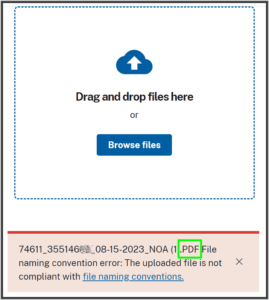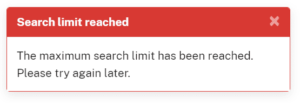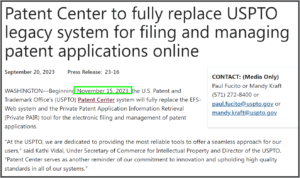
The USPTO developers don’t even play by their own rules, as I will describe here. Continue reading “USPTO developers fail to play by their own rules — “PDF””

Bluesky: @oppedahl.com

The USPTO developers don’t even play by their own rules, as I will describe here. Continue reading “USPTO developers fail to play by their own rules — “PDF””

Just now I logged in at Patent Center and tried to view my outgoing correspondence. I was greeted with a big red error message saying Search Limit Reached. This is bug number CP178. I opened EBC ticket number 1-843318724. EBC agent 50 checked with the Patent Center team and reported back that this is a feature, not a bug. This feature blocks data mining, he explained. Continue reading “Patent Center is not ready, and PAIR cannot be shut down tonight”
Readers will recall that originally the USPTO was firm in its commitment to a shutdown of PAIR and EFS-Web at 11:59 PM on November 7, 2023 (blog article).
Readers will also recall that with less than two hours remaining before the close of business on November 7, the USPTO blinked and did not shut down PAIR and EFS-Web that day (blog article). Instead, the USPTO postponed the shutdown of PAIR and EFS-Web by four business days. The shutdown got postponed to 11:59 PM today, November 14.
Yes, the USPTO has firmly stated today is the day that it will shut down PAIR and EFS-Web. This will happen at 11:59 PM tonight.
On November 5, 2023, I predicted (blog article) that the USPTO leadership would take corrective action in response to the situation that EBC would often tell a caller that the way to overcome a bug in Patent Center was to go back and do the task using PAIR or EFS-Web. And my prediction has turned out to be correct. USPTO leadership has indeed taken corrective action about this situation. Continue reading “USPTO leadership has taken corrective action”
One of the most striking disconnects during the October 18 meeting with Commissioner for Patents Vaishali Udupa was the topic of “what happens after a USPTO customer opens an EBC (Electronic Business Center) trouble ticket about a Patent Center bug?” Continue reading “Waiting to hear about EBC tickets from Commissioner for Patents Udupa”

(Update: the migration has now been postponed for a third time, see blog article.)
On October 31, 2023, the USPTO announced that December 4, 2023 was the date upon which a new system called IPAS (Intellectual Property Assignment System) will replace EPAS (Electronic Patent Assignment System) and ETAS (Electronic Trademark Assignment System). See screen shot at right. But now the release date has been pushed back. One wonders whether IPAS will disappoint its users, as will be discussed. Continue reading “USPTO pushes back the date to release “son of EPAS/ETAS””

It is embarrassing to see the USPTO trying to conceal its “blink” on Patent Center that happened on November 7, 2023. Continue reading “USPTO tries to conceal the Patent Center “blink””
It will be recalled that with less than two hours to go before the close of business on the day that the USPTO had resolutely determined that it was going to shut down the trusted PAIR and EFS-Web systems, the USPTO blinked. (See blog article.) The USPTO decided to postpone the shutdown by four business days, from November 8 to November 15. What excuses did the USPTO provide for this blink? One of the excuses was that the USPTO proposed, during those four days, to “increase usability for sponsored accounts with large amounts of customer numbers”. What exactly does this word salad mean? Continue reading ““Increase usability for sponsored accounts with large amounts of customer numbers” means what?”
(Update: be sure to look at Richard Schafer’s comment below, about how to whitelist in Microsoft’s system.)
Hello to the members of the various listservs hosted by Oppedahl Patent Law Firm LLC. Five days ago I migrated the listservs to a new server. For many members of the listservs, it looks like this migration has gone largely unnoticed after a few test postings of yesterday and today. But for some members, this migration has not worked out well, because of the behavior of their email service provider, which is called “Outlook” from Microsoft. Continue reading “Listervs have been migrated to a new server redux”
 Yesterday the USPTO blinked (a little) about the planned shutdown of PAIR and EFS-Web. Here is IPWatchdog’s take on the blink.
Yesterday the USPTO blinked (a little) about the planned shutdown of PAIR and EFS-Web. Here is IPWatchdog’s take on the blink.